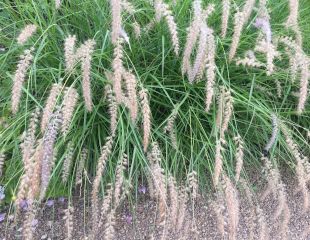
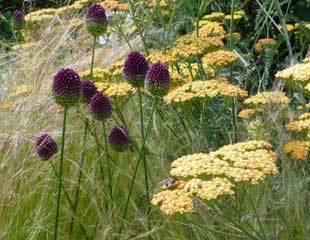
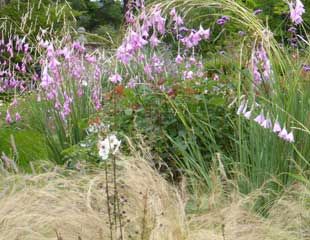
How to Grow Ornamental, Decorative and Garden Grasses
Ornamental, decorative and garden grasses are a popular garden choice — low maintenance, easy to grow, graceful, and full of movement.
On a summer day, they shimmer and dance in the light, and in winter, they sparkle with frost and snow. Whether grouped or paired with perennials, ornamental grasses bring texture and life to every border.
Ornamental grasses make me as lyrical as I can be about any garden plant.
The new garden at RHS Bridgewater has inspirational planting of grasses. Here, you will see grasses planted in mass, and the movement in them is captivating. If you want to see a growing masterclass in Ornamental grasses, RHS Bridgewater is well worth a visit. I also have lots of images, Wonderful Grasses Pinterest.
Explore my complete guide to ornamental grasses below — including how to care for and plant garden grasses, winter interest, and beautiful planting combinations.
How To Grow Ornamental Grasses
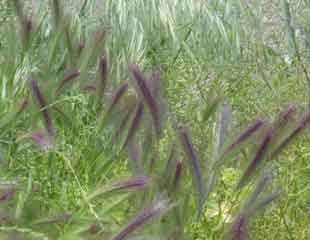
On this page, there are descriptions and growing advice about 10 of the best garden grasses, including planting and growing conditions.
Ornamental Grasses in Winter
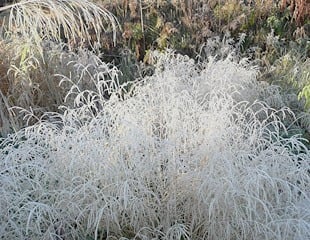
Grasses are not just for summer. Discover grasses that shine in frost and snow, adding sparkle to the garden. See Winter Inspiration.
Best Planting Combinations
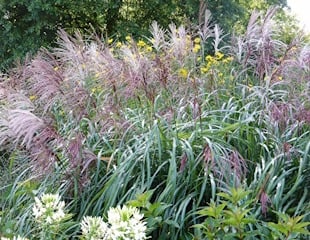
Ornamental grasses look stunning combined with summer perennials. Explore planting combinations.
Pros and Cons of growing ornamental grasses
Easy to grow
Low maintenance
Add movement and style
Tactile, ideal for a sensory garden
Many have good autumn colour
Not all varieties are frost hardy
Can look a bit untidy in exposed windy settings
With winter wind and storms, the plumes on taller varieties get battered and debris blow around the garden
Designing with Ornamental Grasses
10 of the Best easy to grow Grasses
Listed below are some popular and easy-to-grow grasses. These are all readily available online and in garden centres.
It is always worth checking the frost hardy rating of the grass before setting your heart on it. Some grasses on sale may be spectacular but not fully hardy in the UK. If the label says "needs winter protection," it is not likely to be hardy and will need care over the winter. This will usually mean covering with some form of protection during cold periods, and removing cover during milder spells.
Stipa Tenuissima
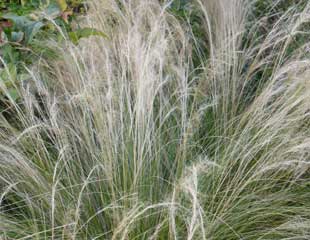
Key Facts
Height: up to 6o cm
Light: Full Sun
Soil: Well-drained, does not grow well on heavy soils.
Special features: Stipa tenuissima is a favourite with many soft, fluffy flower heads. Fully hardy, easy to grow.
S. Tenuissima is fast growing up to around.6m. It needs nothing more than a trim back in the spring and a sunny, well-drained spot. S. Tenuissima is also illustrated top right image, with Dierama, Angel's fishing rod. S.tenuissima looks good with many garden plants including late flowering perennials such as Echinacea purpurea, Helenium and with Allium sphaerocephalon, which is the late flowering variety. Drought tolerant.
Stipa calamagrostis
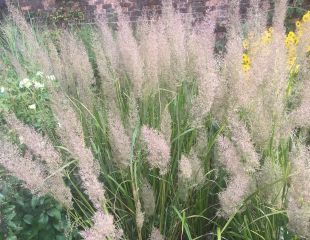
Key Facts
Height: up to 1.2m
Light: Best in sun will tolerate partial shade
Soil: well drained
Special features: fully hardy, also known as peasant grass, this is another very tactile, multi-stemmed variety of Stipa. The plumes are soft and become more open as the plant flowers. Cut back any remaining growth in early spring to prepare for new growth, as it will die back over winter. Drought-tolerant once established.
Stipa Gigantea
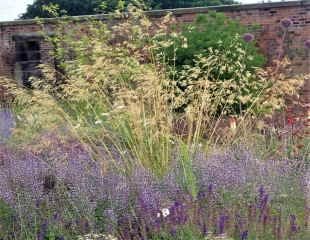
Key Facts
Height: Up to 2m.
Light: Sun or partial shade
Soil: Average to moist
Special features: Fully hardy, also known as Golden Oats.It is semi-evergreen, and it is best to remove dead leaves in spring. It is a tough grass tolerant of many types of growing conditions and will self-seed around, including into boggy areas. Because of its golden colour, it looks good planted with mauves and blues, as in the image which I took at
RHS Bridgewater.
Pennisetum orientale 'Shogun'

Key Facts
Height: 1.2m
Light: Full Sun
Soil: Any apart from damp/boggy conditions
Special features:
An arching grass with light pink spikes, which turn a shade of red/tan as the summer progresses. Also known as fountain grass because of its arching habit.
Molinia common name Purple Moor Grass
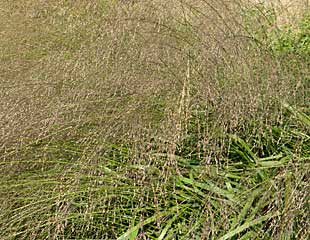
Key Facts
Height: 50-180cm, depending on variety
Light:best in sun or partial shade
Soil:any
Special features: A UK native. fully hardy and easy to grow. Molinia is more attractive than the image depicts. This grass is airy, will shimmer, and M.caerulea, known as Purple Moor grass, has a delicate mauve hue and good autumn colour.
Miscanthus
Key Facts
Height: under 1m to 2.5m, depending on variety
Light: Sun or light shade
Soil: Any except wet
Special features: fully hardy, easy-to-grow group of decorative grasses. Illustrated below are M. sinensis zebrinus, also known as zebra grass, and below right M. sinensis 'Positano', which has the most attractive light purple flower heads. Miscanthus is cut down to the base in February to allow fresh growth and to check the height of taller species. All Miscanthus are deciduous perennials, although many of the plumes and leaves may dry out stay in place over winter.
M. sinensis zebrinus
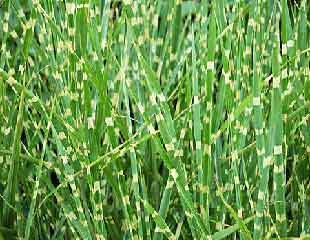
M. sinensis zebrinus, also known as Zebra grass, is admired for its striped leaves. Up to .45m, it has plumes in summer which are not dissimilar to the now-relegated Pampas grass.
M. sinensis 'Positano
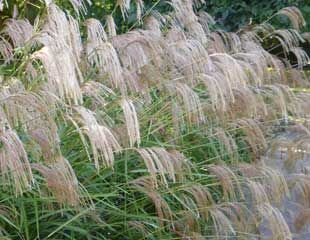
Another variety of Miscanthus, the very handsome M. sinensis 'Positano. Attractive light silver flower heads with good autumn colour. Common name Chinese Silver Grass. Tall up to 2m with an arching habit.
Miscanthus nepalensis

Fully hardy, sun-loving Miscanthus nepalensis has striking plumes in pale mauve. Common name Himalayan Fairy Grass reaches up to 1m
Deschampsia cespitosa a native uk grass
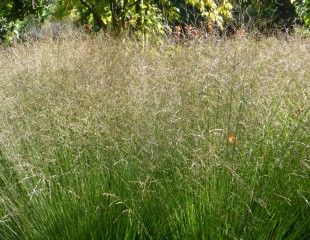
Key Facts
Height: around .75m
Light: Sun or light shade
Soil: Any except wet
Special features: Native to the UK, fully hardy and easy to grow.Evergreen, or semi-evergreen, Common name tufted hair grass, with an arching habit and plumes in the summer.
Calamgrostis x acutiflora 'karl Foerster'
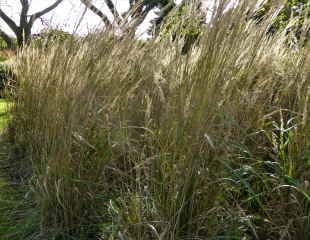
Key Facts
Height: around 1.-1.5
Light: Sun or light shade
Soil: Any except wet
Special features: Common name feather reed grass, it has a tall, erect habit which starts green, turning buff as the season progresses.Herbaceous, fully hardy.
Carex elata 'Aurea' Bowles golden sedge
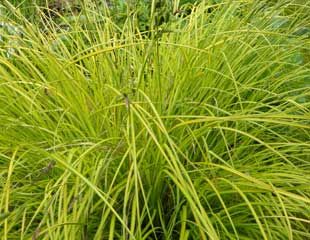
Key Facts
Height: .6m
Light: sun or partial shade
Soil: any, including wet
Special features: perennial, evergreen, technically a sedge, common name golden sedge has bright greenish yellow foliage with an arching habit. Tough, tolerant ideal next to pond. Hardy to H6.
Let go of your lawn

If you want to start a grass garden without all the expense of buying lots of different grasses, why not let your lawn grow?
Illustrated in the image and video is "ordinary" lawn grass left to grow longer and it makes a lovely feature. The grass flowers in June, has little or no air miles and involves less mowing, definitely worth a try.
The importance of the hardy rating
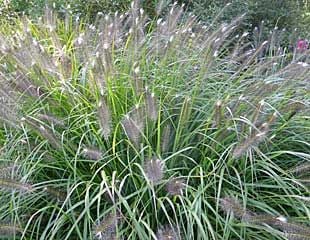
There are some fabulous ornamental grasses on sale in the garden centres and online, but some are not fully hardy, which can be a problem in many parts of the UK. Not all plant labels make clear the hardy rating of a grass, and this is very important.
Illustrated left is a very popular ornamental grass, Pennisetum alopecuroides, commonly known as fountain grass 'Red head', which looks just fabulous. But it is H3 rating, which means it is only hardy in mild or coastal areas, and will require winter protection, without which it is liable to be killed by winter weather. Plants are expensive, and it's very disappointing when they do not come back the following year. It's not just a question of right place right plant, the Hardiness rating is critical.
